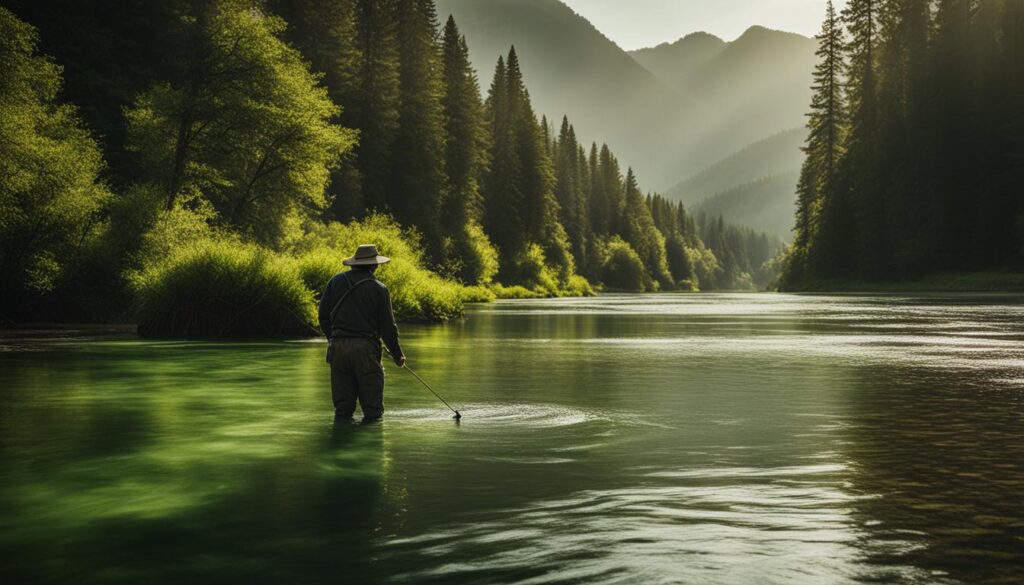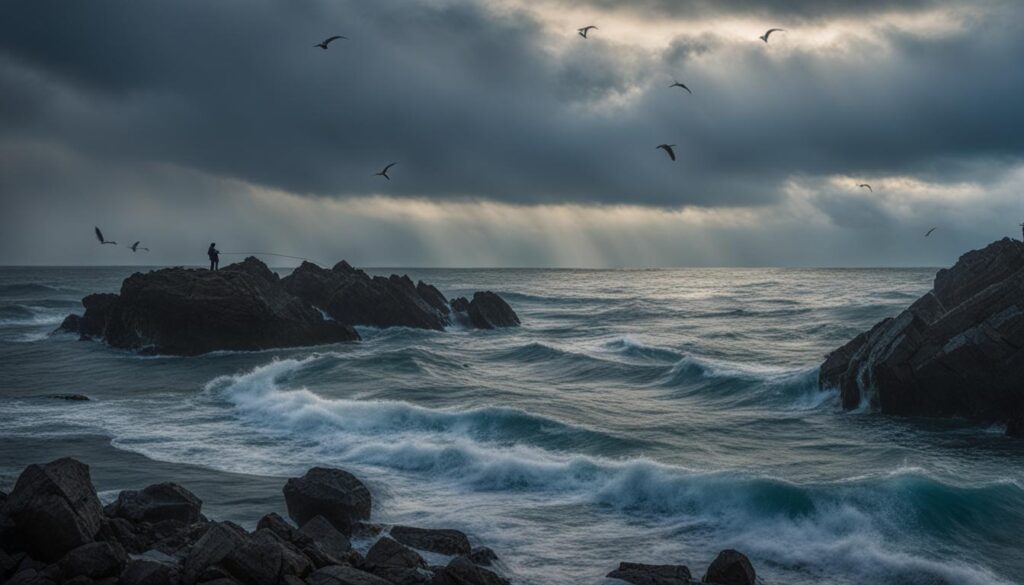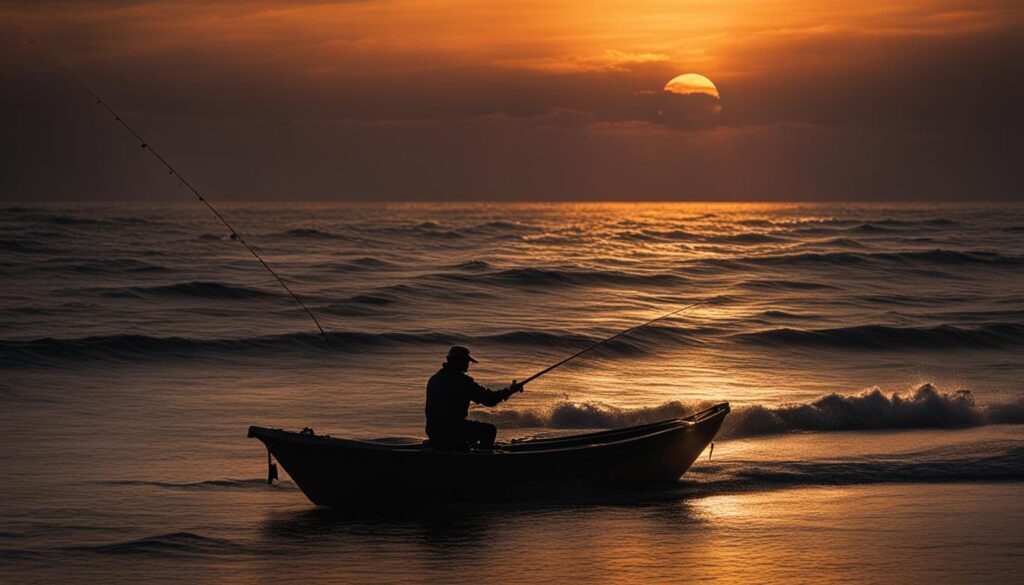We may earn money or products from the companies mentioned in this post.
Do you want to experience the thrill of catching fish from the shore or off a pier? Whether you are a seasoned angler or a beginner, Shore and Pier Fishing are exciting forms of fishing that offer unique challenges and opportunities. In this comprehensive guide, we will provide you with expert tips and techniques to help you enhance your Shore and Pier Fishing experience.
From finding the best spots to understanding the gear and selecting the right bait, we’ll walk you through everything you need to know to become a successful shore and pier angler. We’ll also cover essential safety and etiquette guidelines to ensure a positive fishing experience for everyone.
So, if you’re ready to cast your line and reel in your next big catch, read on and discover the secrets to successful Shore and Pier Fishing.
Key Takeaways:
- Shore and Pier Fishing offer unique challenges and opportunities for anglers.
- Understanding the basics of Shore and Pier Fishing is essential for a successful fishing trip.
- Essential gear for Shore and Pier Fishing includes rods, reels, tackle, and safety equipment.
- Choosing the right bait or lure is crucial to attracting fish to your line.
- Shore fishing requires specific techniques to effectively present your bait or lure to the fish.
Understanding Shore and Pier Fishing
Before you head out on your next fishing trip, it’s essential to understand the basics of Shore and Pier Fishing. Both methods have their unique advantages and offer fantastic opportunities to catch a wide variety of fish species.
Shore fishing is best suited for anglers who prefer casting their line from the shoreline, while pier fishing allows you to cast your line from a variety of elevations, increasing your chances of catching fish.
When it comes to finding the best spots for shore and pier fishing, research is key. Look for locations with plenty of underwater structures, such as rocks, reefs, and drop-offs, as these areas tend to attract more fish. Other factors to consider include water depth, water temperature, and tidal currents.
Best Spots for Shore Fishing
When it comes to shore fishing, the best spots are often rocky shorelines, jetties, and beaches. These areas provide excellent habitat for a wide variety of fish species, including striped bass, bluefish, and flounder.
| Type of Fish | Best Shore Fishing Spots |
|---|---|
| Striped Bass | Rocky shorelines, jetties |
| Bluefish | Beaches, rocky shorelines, jetties |
| Flounder | Beaches, estuaries, sandy bottoms |
Keep in mind that different fish species have different preferences when it comes to their habitat and feeding patterns. Do your research and experiment with different locations, bait, and techniques to find the ideal spot for your target species.
Best Spots for Pier Fishing
Pier fishing offers several advantages over shore fishing, such as the ability to cast your line further and reach deeper water. When searching for the best pier fishing spots, look for piers located near rocky reefs, underwater structures, or deep channels.
| Type of Fish | Best Pier Fishing Spots |
|---|---|
| Snook | Piers near rocky reefs, jetties |
| Redfish | Piers near deep channels, underwater structures |
| Spanish Mackerel | Piers near baitfish schools, channels |
Keep in mind that pier fishing can be affected by seasonal changes, such as water temperature and fish migration patterns. Research the best pier fishing seasons for your target species and adjust your techniques accordingly.
Essential Gear for Shore and Pier Fishing
Shore and pier fishing require specific gear to ensure a successful catch. Here’s a comprehensive list of essential pier fishing gear:
| Gear | Description |
|---|---|
| Rod and reel | A sturdy rod and reel combo capable of handling the size of fish in the area. |
| Line | Monofilament or braided line with a pound test appropriate for the target species. |
| Terminal tackle | Terminal tackle includes hooks, sinkers, and swivels. Hooks sizes and types depend on the bait. |
| Bait and lures | Bait and lures need to be selected based on the target species. |
| Fishing knife and pliers | A multi-purpose fishing knife and pliers are essential for cutting lines and removing hooks from fish. |
| Cooler | For keeping fish fresh until it’s time to head home. |
| Sunscreen and hat | Both are essential for preventing sunburn. |
| Appropriate clothing and footwear | Avoid sandals or open-toed shoes when fishing, as sharp rocks and hooks can cause injury. |
Make sure you have all the right gear before you head out to your favorite pier fishing spot. Having the correct gear can make all the difference in your fishing experience.
Bait and Lure Selection for Shore and Pier Fishing
The key to a successful catch is using the right bait or lure when shore and pier fishing. The type of bait or lure you choose will depend on the target fish species and the environmental conditions.
Choosing Bait for Pier Fishing
Pier fishing typically requires strong-smelling bait to attract fish from a distance. Live bait is also an excellent option as it appears more natural to fish. Here are some popular types of pier fishing bait:
| Bait Type | Target Species |
|---|---|
| Squid | Snapper, Grouper, Flounder |
| Shrimp | Pompano, Trout, Redfish |
| Mackerel | Kingfish, Cobia, Tuna |
Choosing Lures for Shore Fishing
Lures can be an excellent choice for shore fishing as they imitate the movements of live bait. When selecting a lure, consider the water visibility and the target species’ feeding habits. Here are some popular types of shore fishing lures:
- Jigs: Effective for bottom-feeding fish like flounder
- Spoons: Good for aggressive species like bluefish
- Topwater lures: Ideal for attracting surface-feeding fish like striped bass
Experimenting with different types of bait and lures can often lead to better results. Always remember to check local fishing regulations before choosing your bait or lure as some areas may have specific rules.
Techniques for Shore Fishing
Shore fishing can be a relaxing and rewarding way to catch fish, but it requires specific techniques to increase your chances of success. By mastering the following shore fishing techniques, you’ll be able to adapt to different scenarios and improve your catch rate.
Casting Technique
The casting technique is one of the most important aspects of shore fishing. To cast successfully, hold your rod with one hand and the line in the other hand. Pull back the rod, then quickly bring it forward while releasing the line. The bait or lure will fly out into the water. Practice makes perfect, so keep trying until you find the right rhythm and distance.
Retrieving Technique
Retrieving your bait or lure is essential to attract fish to your line. Try different retrieval techniques, such as reeling in quickly or pausing occasionally to give the bait a more natural movement. Pay attention to the depth of the water and adjust your retrieval technique accordingly.
Reading the Water
Understanding the water and how fish behave in it is crucial for shore fishing. Look for areas of shallow and deep water, weed beds, rocks, or other structures that fish might use for cover. Cast your line near these areas to increase your chances of a bite.
Be Patient
Patience is the key to successful shore fishing. Fish might not bite immediately, so be prepared to wait for a while. Don’t get discouraged if you don’t get a bite right away. Keep trying different techniques until you find what works best for you.
By mastering these shore fishing techniques, you’ll be able to enjoy a more productive fishing experience along the shoreline. Remember to respect the environment and practice safe fishing practices.
Techniques for Pier Fishing
When it comes to pier fishing, selecting the right gear and using the correct techniques are key to success. In this section, we will cover pier fishing rigs, selecting the right bait, and understanding the seasonal patterns of fish behavior.
Pier Fishing Rigs
The right rig setup can make all the difference in attracting fish to your line. One of the most popular pier fishing rigs is the two-hook bottom rig. This rig consists of two hooks tied to the leader, with a sinker at the bottom to keep the bait in place. Another popular rig is the Carolina rig, which features a sliding sinker and a swivel to reduce line twist.
| Rig Type | Advantages | Disadvantages |
|---|---|---|
| Two-hook bottom rig | Good for catching multiple fish at once | Bait can get tangled in the hooks |
| Carolina rig | Minimizes line twist | Requires more setup time |
Selecting the Right Bait
The type of bait you choose to use will depend on the species of fish you are targeting. For pier fishing, some of the most popular bait options include shrimp, squid, and cut bait. It’s also a good idea to bring a variety of bait options to see what the fish are biting that day.
Pier Fishing Seasons
Understanding the seasonal patterns of fish behavior can also increase your chances of success in pier fishing. In the spring and summer months, fish may be more active and feeding closer to the surface, while in the fall and winter months, they may be deeper and more sluggish. It’s essential to adjust your bait and rig setup accordingly to match the seasonal patterns.
With the right techniques and gear, pier fishing can be a thrilling and rewarding experience. Whether you’re a seasoned angler or a beginner, mastering these techniques can help you increase your catch rate and enjoy the excitement of reeling in your next big catch.
Safety and Etiquette for Shore and Pier Fishing
While enjoying the thrill of fishing, it’s essential to prioritize safety and practice proper fishing etiquette to ensure a fun and safe experience for yourself and fellow anglers. Here are some essential tips:
Safety Tips for Shore and Pier Fishing
- Check weather conditions before heading out to fish.
- Wear appropriate clothing and footwear for the weather and location.
- Apply sunscreen and wear a hat to protect yourself from the sun.
- Be aware of your surroundings and watch out for potential hazards such as slippery rocks or strong currents.
- Always wear a life jacket when fishing from a pier.
- Keep a first-aid kit on hand and know how to use it.
Fishing Etiquette for Shore and Pier Fishing
- Respect the environment by not leaving any trash or debris behind.
- Follow local fishing regulations and obtain the necessary permits before fishing.
- Be aware of other anglers and give them plenty of space to fish.
- Avoid casting your line over other anglers’ lines to prevent entanglement.
- Do not disturb marine life unnecessarily, such as by throwing rocks or sticks into the water.
- Always be polite and courteous to fellow anglers and other beach-goers.
Remember, safety and respect are crucial to ensuring a positive fishing experience for everyone involved.
Conclusion:
Shore and Pier Fishing can be an exhilarating and rewarding experience for anglers of all levels. Whether you’re casting your line from the shoreline or fishing off piers, there are a few key takeaways to ensure a successful trip.
Be Prepared
Before embarking on your fishing adventure, make sure you have all the necessary gear, including rods, reels, bait, and safety equipment. Being well-prepared will ensure that you can tackle any fishing situation that comes your way.
Choose the Right Spot
Understanding the best spots for shore and pier fishing can make a significant difference in your catch rate. Take the time to research the area and ask locals for advice. Factors like weather conditions, tide patterns, and water depth can all impact your success.
Master Your Techniques
Whether you’re fishing from the shore or a pier, there are specific techniques to master to improve your chances of a successful catch. Practice your casting and retrieving techniques, and learn to read the water to understand where fish are likely to be located.
Stay Safe and Respectful
While enjoying your fishing experience, it’s crucial to prioritize safety and practice proper fishing etiquette. Always wear appropriate safety gear, like a life jacket or sunscreen, and respect the environment by properly disposing of any trash. Additionally, be considerate of other anglers and follow any posted rules and regulations.
With these tips and techniques in mind, you’ll be well-equipped to make the most of your next Shore and Pier Fishing adventure. Remember to stay safe, respect the environment, and enjoy the thrill of reeling in your next big catch!
FAQ
What is shore fishing?
Shore fishing refers to the act of fishing from the shoreline, such as the beach, riverbank, or lake edge, without the use of a boat or other watercraft.
What is pier fishing?
Pier fishing involves fishing from a pier or a structure that extends over the water. Piers provide anglers with access to deeper water and can be found along coastlines, harbors, and lakes.
What are the advantages of shore fishing?
Shore fishing allows you to access fishing spots without needing a boat or any specialized equipment. It’s a great option for beginners or anglers who prefer fishing at their own pace and exploring various shorelines.
What are the advantages of pier fishing?
Pier fishing offers the opportunity to access deeper water and target fish species that may not be easily reachable from the shoreline. Piers also often provide amenities such as benches, rod holders, and cleaning stations for angler convenience.
Where are the best spots for shore and pier fishing?
The best spots for shore and pier fishing can vary depending on your location. Generally, areas near structures like jetties, piers, or rock formations tend to attract fish. Researching local fishing reports, talking to experienced anglers, or consulting fishing guides can help you identify the best spots in your area.
What are some essential gear items for shore and pier fishing?
Essential gear items for shore and pier fishing include fishing rods, reels, fishing lines, hooks, sinkers, and a tackle box to store your gear. Additionally, items like a fishing net, a cooler for storing caught fish, sunglasses, and a hat for sun protection are recommended.
How do I choose the right bait or lure for shore and pier fishing?
The choice of bait or lure depends on various factors, such as the target fish species and the fishing conditions. Live bait, such as worms or shrimp, is commonly used for shore and pier fishing. Additionally, artificial lures, such as spoons, jigs, or soft plastics, can be effective in attracting fish. Experimenting with different baits and lures can help you determine what works best in your fishing location.
What are some techniques for shore fishing?
Shore fishing techniques include casting, retrieving, and reading the water. Casting involves accurately casting your line to the desired spot. Retrieving refers to the way you retrieve your bait or lure, such as a slow retrieve or a jigging motion. Reading the water involves observing the currents, tides, and potential fish-holding structures to strategically position yourself for a better chance of catching fish.
What are some techniques for pier fishing?
Techniques for pier fishing include setting up rigs, selecting the right bait, and understanding seasonal fish behavior. Using a pier fishing rig, such as a fishfinder rig or a Carolina rig, can increase your chances of hooking fish. Selecting the right bait that matches the preferences of the target species is essential. Additionally, understanding how fish behavior changes throughout the seasons can help you plan your fishing trips more effectively.
How can I practice safety and etiquette while shore and pier fishing?
To ensure safety while shore and pier fishing, always check the weather conditions before heading out and be aware of any potential hazards. Protect yourself from the sun by wearing sunscreen and appropriate clothing. Additionally, it’s important to respect the environment by properly disposing of trash and fishing responsibly to preserve the natural habitat. When fishing on piers, adhere to any posted rules and be considerate of other anglers.
Affiliate Disclosure: This post may contain affiliate links. If you purchase through our link, we may receive a small commission, but at no additional cost to you. For more information, please see our Disclosure statement.



